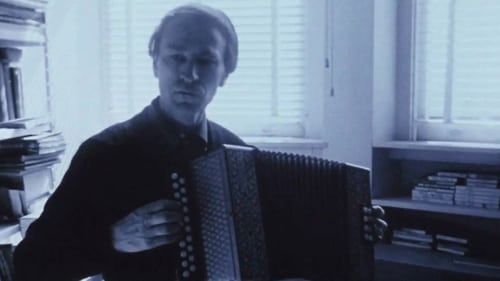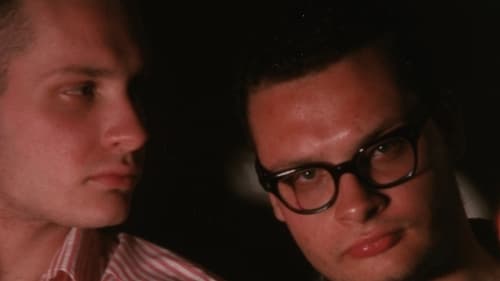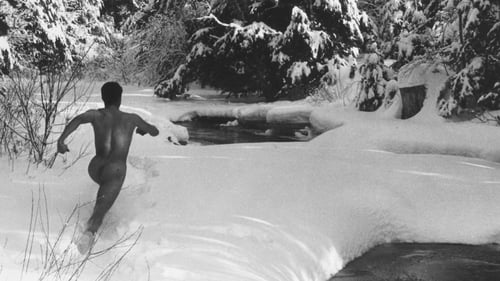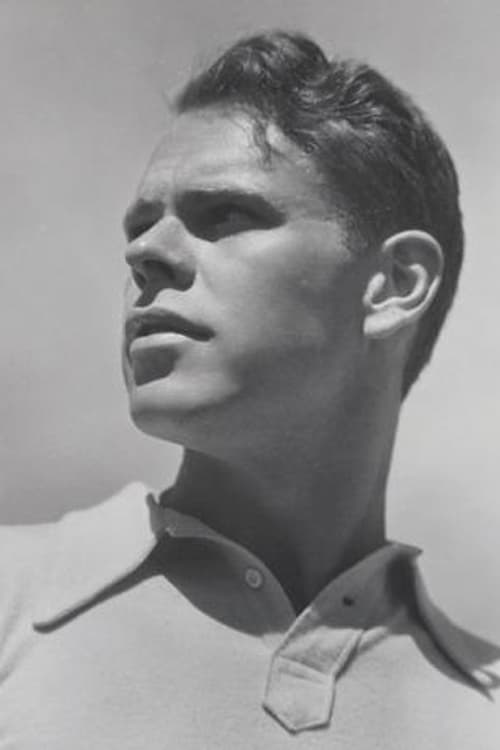Jerome Hill
출생 : 1905-03-02, St. Paul, Minnesota
사망 : 1972-11-21
약력
Jerome Hill (March 2, 1905 – November 21, 1972) was an American filmmaker and artist. He was educated at Yale, where he drew covers, caricatures and cartoons for campus humor magazine The Yale Record.
His 1950 documentary Grandma Moses, written and narrated by Archibald MacLeish, was nominated for an Academy Award for Best Short Subject, Two-reel. He won the 1957 Academy Award for Best Documentary Feature for his film Albert Schweitzer.
In addition to making films, he was a painter and composer.
His last film, the autobiographical Film Portrait (1973), was added to the National Film Registry in 2003.
Description above from the Wikipedia article Jerome Hill, licensed under CC-BY-SA, full list of contributors on Wikipedia.

Self
Filmmaker Jonas Mekas films 160 underground film people over four decades.

Music
In 1950 Jerome Hill went to Zurich with the intention of making a film about Dr. Carl G. Jung. The project was abandoned when Hill decided that Jung was not a good subject. After Hill's death, Jonas Mekas edited the film which focuses on Dr. Jung as a person.

Director
In 1950 Jerome Hill went to Zurich with the intention of making a film about Dr. Carl G. Jung. The project was abandoned when Hill decided that Jung was not a good subject. After Hill's death, Jonas Mekas edited the film which focuses on Dr. Jung as a person.

Self
During the summer of 1966 Jonas Mekas spent two months in Cassis, as a guest of Jerome Hill. Mekas visited him briefly again in 1967, with P. Adams Sitney. The footage of this film comes from those two visits. Later, after Jerome died, Mekas visited his Cassis home in 1974. Footage of that visit constitutes the epilogue of the film. Other people appear in the film, all friends of Jerome.

Editor
The life of Jerome Hill corresponded with the first formative decades of cinema and a greater part of the 20th century. Through fragments of Hill’s surrealistic, handpainted and documentary films (as well as the James J. Hill family's home movies), this autobiographical work serves as an aesthetically complete documentary of Jerome Hill as an artist and offers a personal perspective of the seventh art.

Himself
The life of Jerome Hill corresponded with the first formative decades of cinema and a greater part of the 20th century. Through fragments of Hill’s surrealistic, handpainted and documentary films (as well as the James J. Hill family's home movies), this autobiographical work serves as an aesthetically complete documentary of Jerome Hill as an artist and offers a personal perspective of the seventh art.

Music
The life of Jerome Hill corresponded with the first formative decades of cinema and a greater part of the 20th century. Through fragments of Hill’s surrealistic, handpainted and documentary films (as well as the James J. Hill family's home movies), this autobiographical work serves as an aesthetically complete documentary of Jerome Hill as an artist and offers a personal perspective of the seventh art.

Writer
The life of Jerome Hill corresponded with the first formative decades of cinema and a greater part of the 20th century. Through fragments of Hill’s surrealistic, handpainted and documentary films (as well as the James J. Hill family's home movies), this autobiographical work serves as an aesthetically complete documentary of Jerome Hill as an artist and offers a personal perspective of the seventh art.

Director
The life of Jerome Hill corresponded with the first formative decades of cinema and a greater part of the 20th century. Through fragments of Hill’s surrealistic, handpainted and documentary films (as well as the James J. Hill family's home movies), this autobiographical work serves as an aesthetically complete documentary of Jerome Hill as an artist and offers a personal perspective of the seventh art.

Editor
This film uses an experimental painting technique on documentary footage of the bustling New York streets during Christmastime: Mary, Joseph and the unborn Christ travel through the streets.

Producer
This film uses an experimental painting technique on documentary footage of the bustling New York streets during Christmastime: Mary, Joseph and the unborn Christ travel through the streets.

Writer
This film uses an experimental painting technique on documentary footage of the bustling New York streets during Christmastime: Mary, Joseph and the unborn Christ travel through the streets.

Director
This film uses an experimental painting technique on documentary footage of the bustling New York streets during Christmastime: Mary, Joseph and the unborn Christ travel through the streets.

Self
“1950년부터 영상 일기를 찍었어요. 언제나 볼렉스 카메라를 들고 다니며, 내가 만나게 되는 상황이나 친구, 뉴욕의 모습, 계절의 변화 등 즉각적인 현실에 반응하고자 했죠. 어떤 날에는 열 프레임, 어떤 날에는 10초, 또 어떤 날에는 10분 정도 촬영을 했습니다. 물론, 아무것도 찍지 않은 날도 있었어요. 일기를 쓸 때는 ‘회상’이라는 절차가 수반되는데, 보통 책상에 앉아서 그날 하루를 되돌아보며 일기를 써 내려가기 때문이죠. 한편 영상(카메라) 일기의 경우, 어떤 순간에 대한 즉각적인 반응을 포착할 수 있습니다. 특정 대상을 카메라에 제대로 담던 담지 못하는 것과 관계없이, 순간의 반응 자체를 카메라가 기록합니다. 어떤 상황에 다시 돌아가 촬영을 재개한다면, 그것은 재연된 영상이 되어버리죠. 이는 사건이나 감정이 수반될 수밖에 없습니다. 일어나는 일을 있는 그대로 포착하려면, 내가 사용하고 있는 도구(여기에서의 도구는 볼렉스 카메라를 말한다)에 대한 온전한 이해가 필수적입니다. 내가 반응을 보이는 현실뿐만 아니라 내가 반응함과 동시에 내 감정의 상태(와 모든 기억)까지 포착할 수 있어야 하기 때문이죠. 다시 말해, 카메라를 들고 촬영이 이루어지는 바로 그 장소에서 영상의 구조화(편집) 작업까지 끝낼 수 있어야 합니다. 월든에서 여러분이 만나는 모든 영상은 카메라에 담겨있는 영상과 동일합니다. 1964년부터 1968년까지 촬영한 영상을 순차적으로 연결한 것입니다. 사운드트랙의 경우, 목소리, 지하철 소리, 길거리 소음 등 촬영 당시 수집한 사운드에 쇼팽의 음악-난 로맨틱한 사람입니다-과 때때로 의미 있고 또 때때로 의미 없는 사운드를 섞어 제작하였습니다.”

Director
Live-action footage of canaries and beachgoers overlaid with hand-painted effects.

Director
The filmmaker appears as an artist attempting to set up his easel, with frustrating results.

Music
“After seeing Taylor Mead’s diaries I can’t look around myself anymore. There is so much to see! So now I sit with my back to nature, like Gertrude Stein.” – Julian Beck, The Living Theatre, Paris.

Himself
In March and April of 1966, Markopoulos created this filmic portrait of writers and artists from his New York circle, including Parker Tyler, W. H. Auden, Jasper Johns, Susan Sontag, Storm De Hirsch, Jonas Mekas, Allen Ginsberg, and George and Mike Kuchar, most observed in their homes or studios. Filmed in vibrant color, Galaxie pulses with life. It is a masterpiece of in-camera composition and editing, and stands as a vibrant response to Andy Warhol's contemporary Screen Tests.

Director
Footage of a bullfight, shot by Hill in 1934, hand-painted by the artist three decades later.

Writer
A magic umbrella saves a girl from a mysterious attacker. Filmed in 1927, tinted and hand-colored in the early 60s.

Director
Albert Schweitzer plays phrases and explains to a friend how he thinks Bach should be played.

Director
A magic umbrella saves a girl from a mysterious attacker. Filmed in 1927, tinted and hand-colored in the early 60s.

Producer
Based on Jerome Hill's unpublished novel, Peacock Feathers, this ensemble piece focuses on the relationship between two aging sisters.

Writer
Based on Jerome Hill's unpublished novel, Peacock Feathers, this ensemble piece focuses on the relationship between two aging sisters.

Director
Based on Jerome Hill's unpublished novel, Peacock Feathers, this ensemble piece focuses on the relationship between two aging sisters.

Convict I
Jack and Leo vie for the affections of Vera- who appears a little differently to each man- over the course of a series of energetic sketches, flashbacks and homages.

Art Direction
A little boy and his sister forced to spend a day at the beach build a sand castle, to the delight and interest of others. Rich black and white photography collides with a novel fantasy sequence combining color photography, stop motion and cutout animation. Equal parts Jacques Tati, A. Lamorisse and (Hill's perrenial favorite) C. G. Jung.

Producer
A little boy and his sister forced to spend a day at the beach build a sand castle, to the delight and interest of others. Rich black and white photography collides with a novel fantasy sequence combining color photography, stop motion and cutout animation. Equal parts Jacques Tati, A. Lamorisse and (Hill's perrenial favorite) C. G. Jung.

Director
A little boy and his sister forced to spend a day at the beach build a sand castle, to the delight and interest of others. Rich black and white photography collides with a novel fantasy sequence combining color photography, stop motion and cutout animation. Equal parts Jacques Tati, A. Lamorisse and (Hill's perrenial favorite) C. G. Jung.

Presenter
This biographical docudrama traces the life of Dr. Albert Schweitzer, from his birth in Alsace, up to the age of 30 when he made the decision to go to French Equatorial Africa and build his jungle hospital. The latter half of the film encompasses a full day in the hospital-village, following the octogenarian Samaritan in his daily rounds.

Producer
This biographical docudrama traces the life of Dr. Albert Schweitzer, from his birth in Alsace, up to the age of 30 when he made the decision to go to French Equatorial Africa and build his jungle hospital. The latter half of the film encompasses a full day in the hospital-village, following the octogenarian Samaritan in his daily rounds.

Director
This biographical docudrama traces the life of Dr. Albert Schweitzer, from his birth in Alsace, up to the age of 30 when he made the decision to go to French Equatorial Africa and build his jungle hospital. The latter half of the film encompasses a full day in the hospital-village, following the octogenarian Samaritan in his daily rounds.

Director
In 1951, Jung was filmed at his Bollingen retreat by two Americans, Jerome Hill, an artist and film-maker from Minnesota, and Maud Oakes, an author and researcher, whose book Where the Two Came to Their Father was the first major publication of the Bollingen Foundation. That book described a ritual and ceremonial sequence given to Maud by and old Navajo Medicine Man, along with its accompanying sand paintings. Maud had long been interested in Jung and his new psychology of the collective unconscious. She had met him in 1937 in New York, when she, along with her friends, Paul and Mary Mellon, attended a lecture he gave there.

Producer
1950 short film portrait of the octogenarian folk artist. Nominated for an Oscar in the category "Best Short Subject, One-reel".

Director
1950 short film portrait of the octogenarian folk artist. Nominated for an Oscar in the category "Best Short Subject, One-reel".

Narrator / Jerome
An "autobiographical sketch" centered around small group of vacationers to Hill's estate in Provence-Alpes-Côte d'Azur. A gorgeous and relaxing film-soirée that acted as Jerome Hill's return to cinema after a time away. Workmen construct a walkway to the open air theatre, while friends lounge and hobby, toil and swim.

Music
An "autobiographical sketch" centered around small group of vacationers to Hill's estate in Provence-Alpes-Côte d'Azur. A gorgeous and relaxing film-soirée that acted as Jerome Hill's return to cinema after a time away. Workmen construct a walkway to the open air theatre, while friends lounge and hobby, toil and swim.

Director
An "autobiographical sketch" centered around small group of vacationers to Hill's estate in Provence-Alpes-Côte d'Azur. A gorgeous and relaxing film-soirée that acted as Jerome Hill's return to cinema after a time away. Workmen construct a walkway to the open air theatre, while friends lounge and hobby, toil and swim.

Director
In a European seaside village, a maiden takes clean sheets down from the clothesline. Carrying her basket of linens home, she stops to consult a fortune teller. The cartomancienne sees love in the cards. The young woman pauses to reflect. We then see water, swirling, and into view swims a man, as if just appearing on earth. He arrives on shore - is he just in her mind's eye, or is he real? She weaves a garland for her hair. Will they meet?

Title Graphics
The first student film made at Yale, and one of the earliest student feature films ever made, this adaptation of Henry Fielding's novel was made in the spring of 1927 by a filmmaking collective called the Purity Players, led by S. W. Childs, Jr.

Costume Design
The first student film made at Yale, and one of the earliest student feature films ever made, this adaptation of Henry Fielding's novel was made in the spring of 1927 by a filmmaking collective called the Purity Players, led by S. W. Childs, Jr.





